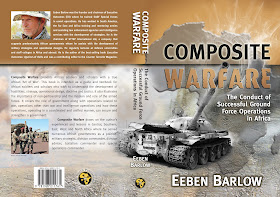In the aftermath of 9/11, the bread and butter of the
defense industry shifted in many ways from focusing on big-ticket Cold War
items like tanks and fighter jets to the world of counterterrorism and
counterinsurgency. With this new paradigm came waves and waves of
self-appointed experts, clueless academics, and hucksters trying to sell crap
to the Department of Defense. This trend continues to this day, although it has
been shifting into the even more nebulous area of cybersecurity, which is even
better for contractors given that the 60-year-old men who run the Pentagon
don’t know anything about computers. The situation is so bad in the Department
of Defense that when you come across an “expert” who dubs themselves a
COINista, you should run, not walk, away. These folks are the
reason why we are fighting the same war today that we were fighting in
Afghanistan 16 years ago.
One person who I always appreciated for having an
actual track record of success is Eeben Barlow.
Having served in the South African Defense Forces as a sapper in the Infantry
and Special Operations, Barlow went on to found a private military company
called Executive Outcomes. EO beat back UNITA in Angola for the
democratically elected government before driving the barbarous
Revolutionary United Front to their knees in Sierra Leone. Today, Barlow
serves as the chairman of STTEP, a PMC that took the fight directly
to Boko Haram.
Oddly, the United States government puts pressure on the host governments to
remove Barlow’s people just as they begin experiencing success in
defeating anti-government forces.
Using his background in counterinsurgency and
irregular warfare, Barlow has recently written a book titled “Composite Warfare,” and it is the go-to manual for warfare in
Africa, written by a man who has experienced it. Barlow emphasizes
an Africa-centric approach that eschews the over-philosophizing of
political scientists, doctrine writers, and alleged COIN experts. Barlow wrote
the book to pertain specifically to war on the African continent, but in this
reader’s opinion, Barlow’s stripped-down language and no-nonsense approach to
what is a normally convoluted subject in military literature makes this
book worthwhile for any student of military history.
As Barlow writes in his book, “Part of the dilemma
African armies face is the continued creation of new words, terms, and phrases
to describe the same action or phenomena. This has led to a large amount of
confusion for commanders and leader in the field.” Using graphics, bullet
points, and written explanations, the author leads the reader to an
understanding about the boots-on-the-ground tactical approach, from movement
techniques and types of operations to the big picture that supports the pillars
of government. “Composite Warfare” ties them together and demonstrates how a
military campaign has to function as a mutually supporting effort that supports
the state rather than undermines it.
Comprehensive in nature, “Composite Warfare” examines
appropriate force structures, air power, reconnaissance, maneuvers, mobility,
air power, intelligence, retrograde operations, developing military strategies,
and plenty more. Barlow treats warfare in Africa with a cultural appreciation,
as opposed to a cookie-cutter, one-size-fits-all approach frequently employed
by U.S. Special Forces, who simply mirror our
own force structure in the host nation counterparts they train.
This is why the United States often trains foreign troops with tactics straight
out of the Ranger
Handbook, tactics that don’t work for indigenous forces.
In a past SOFREP interview with Barlow, he said that
“poor training, bad advice, a lack of strategy, vastly different tribal
affiliations, ethnicity, religion, languages, cultures, not understanding the
conflict and enemy,” were hallmarks of Western training provided to African
armies. “Much of this training is focused on window-dressing, but when you look
through the window, the room is empty,” he concluded.
“Composite Warfare” is recommended reading for
students of military history and strategy, including active-duty Special Forces
soldiers charged with conducting Foreign Internal Defense (FID).
Although the book will prove especially helpful to those serving
in African militaries, “Composite Warfare” will no doubt became a seminal work
on modern warfare in Africa, one practitioners and academics alike will
reference well into the decades to come. Let us hope that Barlow’s lessons are
learned and internalized, lest we repeat the same mistakes in Africa for
another half-century.








